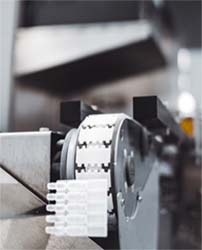Blow-Fill-Seal can be considered both a cost-efficient manufacturing process as well as a relatively low capital expenditure cost to install as compared to traditional glass filling lines. The reasons for this include the following.
A BFS machine is highly reliable and requires little to no human intervention, allowing for good efficiency usage depending on how the facility is set up and other manufacturing factors.
This operational efficiency of BFS can allow for lower variable costs than single-dose glass vials or prefilled syringes on unit-dose packaging for approved drug products.
In addition, BFS often allows for lower upfront capital expenditure to install a new line as compared to traditional glass filling lines.
This is due to a BFS filling line being more compact than a traditional glass filling line. It has no requirement for washing and depyrogenation tunnels on the vial infeed. And there is no need for stoppering and capping stations on the outlet side of the filler.
Finally, having more compact lines and fewer machines allows for better manufacturing space utilization. It also cuts down on the overall qualification requirements since there are fewer machines involved in the initial installation.
The result can be lower per unit manufacturing costs, lower installation costs, less space requirements, and generally faster installation timelines than a modern isolator vial line or pre-filled syringe line.
